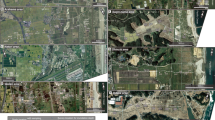Abstract
210Pb geochronology is described mathematically, but how to cut a sediment core is not explicit. Thick sectioning may reduce dating reliability; but on the contrary, thin sectioning is time-consuming. Considering the counting error of excess 210Pb, a new method was proposed for the determination of meaningful thickness for sectioning. The authors applied this method to a core from Tokyo Bay. To increase the thickness with depth, the treatment is helpful in reducing the sample number for measurement and improving the dating accuracy. In addition, the averaging effect involved in sectioning was discussed, and it was confirmed that the averaging effect in the new method on 210Pb geochronology may generally be neglected.








Similar content being viewed by others
References
Appleby PG, Oldfield F (1983) The assessment of 210Pb data from sites with varying sediment accumulation rates. Hydrobiologia 103:29–35
Athy LF (1930) Density, porosity and compaction of sedimentary rocks. Bull Am Assoc Pet Geol 14:1–24
Bay SM, Zeng EY, Lorenson TD, Tran K, Alexander C (2003) Temporal and spatial distributions of contaminants in sediments of Santa Monica Bay, California. Mar Environ Res 56:255–276
Bowman S (1990) Radiocarbon dating. British Museum Publications Ltd., London, pp 38–39
Christensen ER (1982) A model for radionuclides in sediments influenced by mixing and compaction. J Geophys Res 87:566–572
Goldberg EG (1963) Geochronology with 210Pb, radioactivity dating. IAEA, Vienna, pp 121–131
JRIA (1984) Isotope handbook (in Japanese). Maruzen Co. Ltd., Tokyo, p 3
Koide M, Soutar A, Goldberg ED (1972) Marine geochronology with 210Pb. Earth Planet Sci Lett 14:442–446
Krishnaswami S, Lal D, Martin JM, Meybeck M (1971) Geochronology of lake sediments. Earth Planet Sci Lett 11:407–414
Loevinger R, Berman M (1951) Efficiency criteria in radioactivity counting. Nucleonics 9(1):26–39
Masqué P, Isla E, Sanchez-Cabeza JA, Palanques A, Bruach JM, Puig P, Guillén J (2002) Sediment accumulation rates and carbon fluxes to bottom sediments at the Western Bransfield Strait (Antarctica). Deep-Sea Res II 49:921–933
Matsumoto E (1975) 210Pb geochronology of sediments from Lake Shinji. Geochem J 9:167–172
Matsumoto E (1987) Pb-210 geochronology of sediments. Studies of the San’in Region (Natural Environment) 3:187–194
Matsumoto E, Wong CS (1977) Heavy metal sedimentation in Saanich Inlet measured with 210Pb technique. J Geophys Res 82:5477–5482
Oguri K, Matsumoto E, Yamada M, Saito Y, Iseki K (2003) Sediment accumulation rates and budgets of depositing particles of the East China Sea. Deep-Sea Res II 50:513–528
Robbins JA (1978) Geochemical and geophysical applications of radioactive lead. In: Nriagu JO (ed) Biogeochemistry of lead in the environment. Elsevier Scientific, Amsterdam, pp 285–393
Robbins JA, Edgington DN (1975) Determination of recent sedimentation rates in Lakes Michigan using Pb-210 and Cs-137 methods. Geochim Cosmochim Acta 39:285–304
Rubio L, Linares-Rueda A, Dueñas C, Fernández MC, Clavero V, Niell FX, Fernández JA (2003) Sediment accumulation rate and radiological characterisation of the sediment of Palmones River estuary (southern of Spain). J Environ Radioact 65:267–280
Acknowledgements
This study is supported by a grant from the Ministry of Education, Culture, Sports, Science and Technology, Japan (Dynamics of the Sun-Earth-Life Interactive System, No. G-4, the twenty-first century COE program).
Author information
Authors and Affiliations
Corresponding author
Appendix
Appendix
Solution of Eq. 5
Equation 5 can be transformed into
Let \( {{\sqrt {A_0 } } \mathord{\left/ {\vphantom {{\sqrt {A_0 } } {A_0 }}} \right. \kern-\nulldelimiterspace} {A_0 }} = \varepsilon _1 \), Eq. 15 can be written as
Let \(\exp \left( { - \frac{{\lambda h_n }} {{4s}}} \right) = y,\) the equation can be rewritten as
The solution as shown in Eq. 6 is therefore obtained.
The transformation procedure for D
For \(A_x = A_0 \exp \left( { - \frac{{\lambda x}} {s}} \right),\quad n \geqslant 1,h > 0,{\enspace} x_n = \left( {n - \frac{1} {2}} \right)h,\)
Rights and permissions
About this article
Cite this article
Lu, X., Matsumoto, E. How to cut a sediment core for 210Pb geochronology. Environ Geol 47, 804–810 (2005). https://doi.org/10.1007/s00254-004-1209-7
Received:
Accepted:
Published:
Issue Date:
DOI: https://doi.org/10.1007/s00254-004-1209-7




